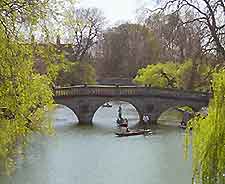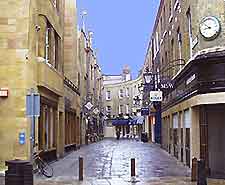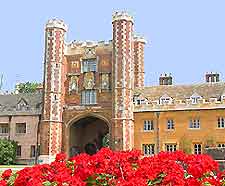Cambridge History Facts and Timeline
(Cambridge, Cambridgeshire, England, UK)

It is thought that in the first century BC, an Iron Age tribe built a settlement on present-day Castle Hill in Cambridge. Under the Romans, it became an important crossing point for legions on the move between Colchester and
Lincoln.
In Saxon times, Cambridge became a modest town. It was known as Grantabryg, because the river on which it stood was then named the Granta, rather than the Cam of today. Under the Normans, the settlement acquired a castle, built to fight the Saxon rebel Hereward the Wake.
The Foundation of Cambridge University
In 1209, the town of Cambridge became inextricably linked with its historic university. Following the outbreak of violence between townsfolk and scholars in
Oxford, a group of scholars went in search of a suitable place to found a new university - and Cambridge was chosen. The first university college, Peterhouse, was founded in 1284 by Hugo de Balsham, later to become the Bishop of Ely.
Other colleges were established in the 14th century, including Clare College in 1326 and Pembroke College in 1347. Finally, in 1497, the Bishop of Ely founded Jesus College. Most colleges were funded by prominent church leaders and statesmen, as well as trade guilds. Throughout the early years of the university's foundation, there were outbreaks of 'town and gown' violence. In 1262, anti-student riots led to the execution of 16 townsfolk.

Cambridge From the 16th Century Onwards
During the 16th and 17th centuries, little changed in Cambridge. It remained a place of narrow streets, set against a backdrop of marshy fenland. However, during this time, the town did see the addition of several new colleges, including Christ's College, Magdalene College, Trinity College, Emmanuel College and finally, Sidney Sussex College in 1596.
By the close of the 1700s, Cambridge could be described as a sizeable town, with its own bank, newspaper, Shire Hall, Guildhall, Senate House and Addenbrookes Hospital. The town even acquired its own Botanic Garden.

Victorian Cambridge
By the time Victoria was on the throne, Cambridge had become a large and wealthy town. In 1845, the railway arrived here, stimulating the growth of new industries and, in turn, bringing about improvements in public utilities.
From 1869, Cambridge University embarked on another period of expansion. In that year, Girton was established as the first women-only college. Two years later, Newnham also opened its doors to female students. Of note, in 1893, electricity was generated in the city for the very first time.
20th-Century Cambridge
The Scott Polar Research Institute was set up in the city in 1920. From the late 1940s, Cambridge University continued to expand, with the addition of several new colleges.
 It is thought that in the first century BC, an Iron Age tribe built a settlement on present-day Castle Hill in Cambridge. Under the Romans, it became an important crossing point for legions on the move between Colchester and Lincoln.
It is thought that in the first century BC, an Iron Age tribe built a settlement on present-day Castle Hill in Cambridge. Under the Romans, it became an important crossing point for legions on the move between Colchester and Lincoln.
